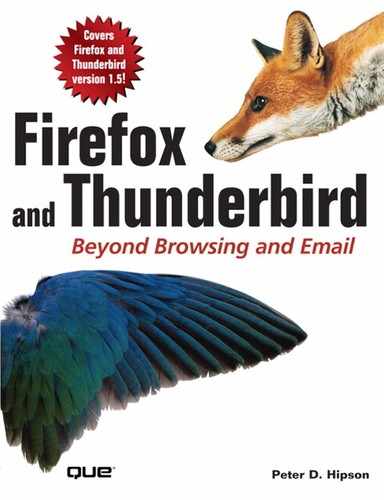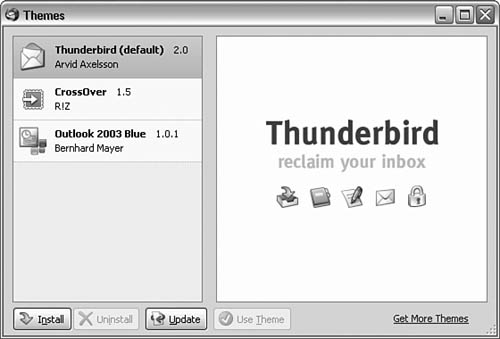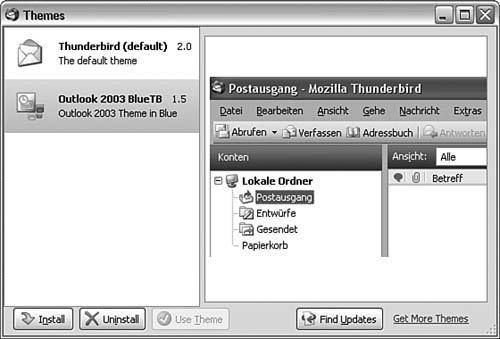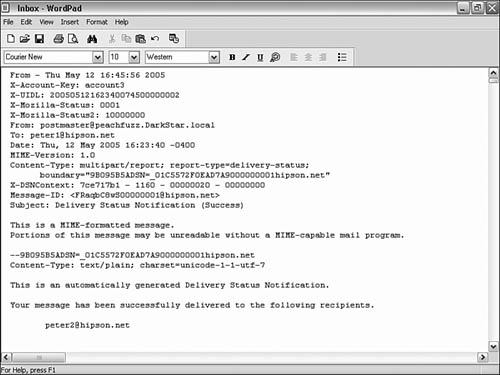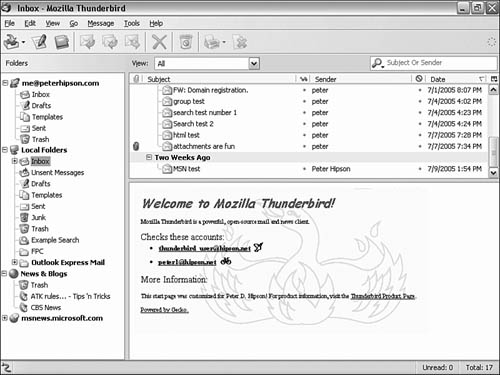IN THIS CHAPTER
This chapter discusses how you can customize and enhance Thunderbird using settings, themes, and extensions. With these customizations, you are able to make Thunderbird look and work exactly the way you want it to.
You can add functionality with extensions and modify the look and feel of Thunderbird with themes.
In addition to themes and extensions, you can set many configuration settings directly from the Thunderbird Options window. However, some preferences are accessible only through direct manipulation of the prefs.js file or the user.js file, or by using the about:config extension.
In fact, in Thunderbird both extensions and themes work much like they do with Firefox. However, neither Firefox themes nor extensions are compatible with Thunderbird. Fortunately, the theme and extension managers are able to check compatibility.
You’ll learn that, just like Firefox, Thunderbird is very customizable and when you are done, you’ll know just how to reclaim your inbox.
Themes are the easiest way you can make major changes to the way Thunderbird looks. A theme can alter virtually any part of the user interface, just as a Firefox theme does.
Most themes change background colors or images, button styles, and other interface features such as border styles and fonts.
In this section, we discuss themes, installing a theme switch, and removing themes. We’ll also cover some common problems users have with themes.
There are fewer Thunderbird themes at Mozilla’s website than for Firefox, but that should not stop you from checking there first for themes.
Going to https://addons.mozilla.org/themes/?application=thunderbird gives you access to the themes Mozilla knows about. (Yes, there probably are also themes on the Internet that are not listed here.) When this was written, about 20 Thunderbird themes were available, in four categories: compact, miscellaneous, modern, and nature.
Another site with themes is http://nightlybuild.at.infoseek.co.jp/help/themes.html. This site’s content is more limited than Mozilla’s site is, but it contains some interesting and different themes.
Theme installation is only a bit more difficult with Thunderbird than with Firefox. The reason for the additional complexity is that Thunderbird is incapable of actually downloading the theme—to do that, you need Firefox.
You can start your installation by finding your theme. Let’s use the theme Outlook 2003 BlueTB, available from the Mozilla website. With Firefox, you first go to the download location (https://addons.mozilla.org/themes/moreinfo.php?application=thunderbird&numpg=10&id=891) and right-click the Install Now hyperlink.
In the Firefox context menu, select Save Link As. In the File Save As dialog box, select a destination folder. You also can optionally change the downloaded theme’s filename. I download my themes to a folder named Thunderbird Themes in my Downloads folder.
After the download completes, close the Downloads window and minimize Firefox.
Next, in Thunderbird, select Tools, Themes. In the displayed window, click the Install button (see Figure 13.1). In the Select a Theme to Install window, navigate to the folder you saved the theme in and click the theme’s JAR file. Then click the Open button.
Thunderbird prompts you with a confirmation of whether you want to install the theme; click OK. At this point, the theme is installed. Just like Firefox, you must click the theme to use it. Then click the Use Theme button. To see the newly selected theme, you must restart Thunderbird—so close and restart it.
Switching themes in Thunderbird is easy. Simply open Thunderbird’s Themes window, click the theme you want to use, and then click the Use Theme button. An even faster way is to simply double-click the theme you want to use.
You must restart Thunderbird to make the newly selected theme active (see Figure 13.2).
Of course, if you don’t like the way Microsoft Outlook looks, there are many other themes you can use. Maybe you will want to delete that Microsoft Outlook theme.
Getting rid of unwanted themes is also done using the Thunderbird Themes window. You can select any theme except for Thunderbird (default) and click the Uninstall button to remove it. Should the theme you are uninstalling be the current theme, Thunderbird switches back to the default theme (ah, so that’s why you can’t delete it…).
When a theme is deleted, the original source JAR file is not deleted, so you either have to manually delete the theme’s JAR file or choose to just ignore it. Ignoring can work best—that way you can reinstall the theme at a later time without having to download it again.
Thunderbird cannot install themes directly from the Internet. Instead, you need to download them (using Firefox) and then install them. One problem some users report is that, when they download some themes, the theme’s extension, which should be .jar, is incorrect. Mozilla recommends renaming the file, changing the incorrect extension to .jar, and attempting to reinstall the theme.
Thunderbird enables you to do some limited customization of the toolbars. Toolbar buttons can be added, moved, and removed from the toolbar; however, you can do this to only a limited set of buttons.
Additionally, an extension is available to improve Thunderbird’s toolbar button support. It’s called Buttons!.
To add buttons to the Thunderbird toolbar, right-click the toolbar and select Customize in the pop-up context menu. The Customize Toolbar window is displayed, with all the unused toolbar buttons.
Each button you add to the toolbar is moved from the Customize Toolbar window to the toolbar, so a button can’t be added in two places. This is in contrast to some other applications, in which a toolbar button can be added in several places.
Three special items on the Customize Toolbar window are the Separator object; Flexible Space object; and Space object, which is used to separate buttons on the toolbar. These special items can be added multiple times, but they merely change the look of the toolbar and don’t add functionality.
The Space object adds a space that is one half the width of a large icon (this space does not shrink or grow when toggling between small and large icons).
The Flexible Space object adds space that enables you to have some buttons forced to the right side of the toolbar. For example, the throbber is on the right because there is a Flexible Space between the last toolbar button and the throbber.
The Separator object places a single vertical line between two buttons, allowing you to create groups of buttons.
Any of the buttons on the toolbar can be removed or rearranged by dragging and dropping them in their new location. To rearrange a button, click and drag the button while the Customize Toolbar window is open.
To remove a button, drag it off the toolbar to the Customize Toolbar window. This puts the button back on the Customize Toolbar window.
These are a few of the extensions that add buttons or extended functionality to Thunderbird:
Buttons!—. An extension that adds a number of useful buttons to Thunderbird (see Figure 13.3). Toolbar buttons included with Buttons! are Archive, Delete Thread, Search, Label, Images, HTML On/Off, Select SMTP, and Delete Junk.
compactfolder—. Makes available a toolbar button to purge and compact folders.
Move Search Items—. Does not add more buttons but allows moving the search bar to the toolbar.
Signature Switch—. Adds a Signature Management button to the toolbar. This extension does more than just add to the toolbar.
Translation Panel—. Adds a button that facilitates translation of content to different languages.
View Headers Toggle Button—. Adds a button that turns on or off message headers. Being able to view the headers is great for trying to track down the source of spam.
Many more toolbar-related extensions can be used but are not listed at the Mozilla Update website.
The Thunderbird window consists of a title bar, menu, toolbar, folders bar, and display area. At the bottom is a status bar showing connection status, the unread message count, and total message counts.
There are three layouts for Thunderbird. Each layout displays at least two panes: Folder and the Message list. Each layout can optionally have a third pane with the contents of the currently selected message (if there is one).
The layouts Thunderbird supports are
Classic view—. This has the Folder list on the left and the Message list on the right. If the Message pane is on, it is displayed below the Message list.
Wide view—. This has the Message pane the full width of Thunderbird’s display area, the Folder pane above on the left, and the Message list above on the right. If the Message pane is not turned on, this view is the same as the Classic view.
Vertical view—. This has the Folder pane on the left, the Message list in the middle, and the Message pane on the right. Again, if the Message pane is not displayed, this view is the same as the Classic view.
Each layout is selected from the Thunderbird View, Layout menu.
If you have the Message pane turned off, the space that would normally have been occupied by it is allocated to the Message list window.
The Folder pane shows all the defined accounts and the folders for each account. The Tree List view lets you expand each account and see folders that belong to the account. Each email account has at least an inbox, a Drafts folder, Templates folder, Sent folder, and Trash folder. If Junk Mail Controls are enabled, you’ll also have a Junk folder.
News and blog accounts have a folder for each RSS feed and a Trash folder.
Newsgroup (NNTP) accounts have a folder for each newsgroup you have subscribed to. There is no Trash folder in newsgroup accounts because messages can’t be deleted. You can, however, attempt to cancel a post you’ve made. Most servers, though, do not handle this properly.
The Message list contains all the messages for an account. Messages are in bold if they are unread and are not bold if they’ve been read. You can mark messages as read or unread at any time. When you mark a message as read and the sender has requested a read receipt (and you have enabled read receipts), the receipt is sent.
The optional Message pane shows the contents of the currently selected message. For email, if the format is HTML, the HTML formatting is applied in this pane. If you have a substantial amount of email, the Message pane is a valuable time-saver because it allows you to quickly peruse your messages without having to explicitly open each one.
The Attachments pane is used to show message attachments. Messages with attachments are indicated in the Message list pane with a paperclip icon. Attachments in the Attachments pane can be right-clicked and then either saved or opened. The standard cautions apply when opening attachments: Unless you know that the attachment is safe, you should run a virus scan or not open it!
The Attachments pane is displayed only if the message has an attachment and if the Message pane is also displayed.
How messages look in the Message pane is, to a limited extent, configurable. To changes the settings, go to Thunderbird’s menu and select Tools, Options.
In the Options window, click the Display button on the left. In the Message Display section (on the right) are settings for both plain-text messages and HTML messages. You’ll also see settings to control the colors for labeled messages; these were described in Chapter 11, “Organizing Email with Thunderbird.”
Plain-text messages have a few more formatting options than HTML messages. For a plain-text message, you can choose to wrap long lines so the message fits the window width without scrolling. You can also choose to display emoticons as graphics.
Another setting is whether to use a fixed width font, such as Courier New, or a variable width font, such as Times New Roman.
Message replies often contain quoted text from the original message. The convention is to annotate a quoted line by setting the first character to a greater than sign (>). This quoting can be nested many levels deep, and email etiquette says you should limit quoting to only necessary material.
Quoted portions can be made bold, italic, bold and italic, or regular text. As well, you can set the size to be regular, bigger, or smaller. A final option lets you set the quoted text’s color—the default is a medium gray.
Generally, HTML messages contain all the formatting as part of the message. However, both the default text color and the default background color can be customized.
Whenever no text color is specified, you can choose to have that text displayed in the color of your choice. The color chosen should contrast well with as many backgrounds as possible; otherwise, the message can be difficult or impossible to read.
When a message has no specified background color, you can specify a background color. Recommendations here are that the color should be light, such as a light gray or light yellow, rather than dark to give good contrast with text that is usually in a darker color or black.
Note
Windows XP/2000 uses an environment variable to hold the location of many of the user-specific files. This variable is %appdata%, and the value is set when the user logs on. This variable can be viewed in a command prompt, although it should never be changed by the user. In virtually any place that a filename and folder are requested, you can insert %appdata%. If you do so, the folder to which %appdata% points is opened. This functionality is available in most applications’ Open and Save dialog boxes, as well. The default for %appdata% in most installations is C:Documents and Settings[User Name]Application Data.
You can also use %appdata% in a shortcut’s Properties dialog box for Target and Start In.
The Thunderbird profile contains everything that makes Thunderbird unique for a certain user, including the user’s email, settings, themes, and extensions. The Thunderbird profile’s basic structure is similar to Firefox’s.
Your profile’s location varies depending on which operating system you are using. The location can also vary if the operating system’s defaults for certain file locations have been changed as well. Most users find these locations to be representative of their systems:
Windows 95/98/Me profiles are usually in
C:WINDOWSApplication DataThunderbirdProfilesxxxxxxxx.default.Windows XP/2000 profiles are usually in
%appdata%ThunderbirdProfilesxxxxxxxx.default.Linux profiles are usually in
~/.mozilla/thunderbird/xxxxxxxx.default/Mac OS X profiles are usually in
~/Library/Application Support/Thunderbird/Profiles/xxxxxxxx.default/.
In all these examples, xxxxxxxx is a series of random letters and numbers. This feature is used to improve security for the user’s profile.
Some of the files and folders located in a typical Thunderbird profile include those in Table 13.1.
Table 13.1. Thunderbird Profile Folder Files and Folders
Filename/Folder Name | Optional | Description |
|---|---|---|
| Mail account information | |
| Default address book | |
| Certificate database | |
| Look and feel folder | |
| Version compatibility information | |
| Component information | |
| Component registrations | |
| Defaults | |
| Installed extensions folder | |
| Collected addresses | |
| Yes | Mail folder for IMAP mail accounts, if any are defined |
| Key database | |
| Configuration information | |
User mail store folder | ||
| View rules | |
| MIME helper file | |
| Thunderbird files list | |
| Basic (initial) preferences; it overrides | |
| Security module database | |
| Bayesian filter word list file | |
| Virtual folder’s version number | |
| Thunderbird configuration file | |
| User interface cache file | |
| Yes | Additional user preferences; it overrides |
| Yes | Thunderbird look and feel Cascading Style Sheet file |
| Yes | Thunderbird content Cascading Style Sheet file |
Each subfolder in the profile’s mail folder contains files for each account folder in Thunderbird. In Figure 13.4, you see nine accounts defined, with a folder in Mail for each account.
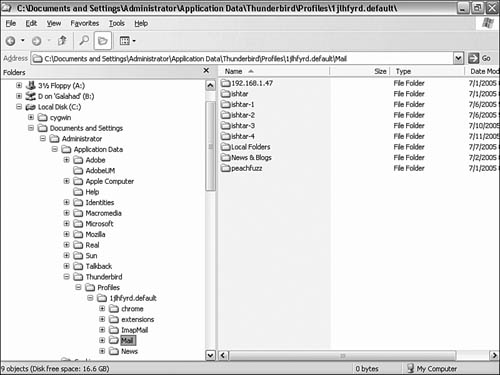
Figure 13.4. This profile’s Mail folder has nine accounts configured, although most users usually have only one or two.
For example the Inbox for an account’s folder would have
Inbox—. A text file that contains all the email stored in this account’s inbox.Inbox.msf—. Message header information and an index for each message stored in the account’s inbox.Inbox.sbd—. A holder for any subfolders for this folder. If no subfolders exist, this folder is empty.
There is no reason to modify many of these files, but a few are editable, either with the about:config extension or a text editor.
A few additional tasks should be performed. Backups are vital—your email is stored in your profile and should be backed up on a regular basis.
Backups are vital to keeping your email data safe from destruction. A minimum backup is to copy a profile into a new location. If this location is on the same computer, and same drive, a drive failure can cause the loss of both the backup and the original data. Only back up locally if you have no other choices, and if you do so, make an offline backup as soon as possible afterward.
If you are running Windows XP and have a CD-R or CD-RW drive, you can easily back up your email to a CD-R or CD-RW disc. It takes just a second to do, while recovery can take much longer.
Making a backup is easy. You need to find your profile; it is usually in c:documents and settingsuseridapplication data hunderbird (where userid is your logon username). Then do the following:
Close all Mozilla applications, especially Thunderbird.
Copy (do not move) the entire Thunderbird folder to a CD-R, CD-RW, or other writable persistent media. Alternatively, copy your profile to a network share on another computer.
Restoring the backup is as easy:
Close all Mozilla applications, especially Thunderbird.
Make a second backup of the current Thunderbird folder as described previously.
Copy the original backup files you saved in the backup procedure to the same location they were originally located. Make sure you get all the files and folders.
Tip
Before doing a restore, I recommend you back up the bad copy of a folder before overwriting it with the backup copy. This can save you if you find the backup is worse than the damaged profile.
There are third-party backup options as well. MozBackup is a small backup utility for Windows users that backs up the profile folders into a compressed file. The file’s extension is .pcv, but it is a standard Zip file; if it’s renamed, Windows XP’s Explorer will open it. You can download MozBackup from http://mozbackup.jasnapaka.com/.
Thunderbird folders are simply large databases that contain all the messages the folder contains. Like databases, when you delete an item such as an email message, the empty space is not automatically recovered. Instead, the message is marked as deleted and the space continues to hold the message.
To recover the deleted messages space, you have to compact the folder. The compacting process rewrites the folder database file without the deleted messages, making it much smaller and more efficient.
Folders are compacted by selecting Files, Compact Folders in Thunderbird’s menu. The amount of time it takes to compact is related to how large the folder is and the performance of your computers. Larger folders with many deleted messages can take longer to compact than smaller folders.
All folders are compacted using this method: To compact an individual folder, right-click the folder and select Compact This Folder from the pop-up context menu.
Unlike Firefox, where one user can have many profiles, Thunderbird users typically have only one. The reason for this difference is that Thunderbird stores more than configurations in the profile. This is where the user’s email messages are stored. (For more information, see the section “Backups,” earlier in this chapter.)
However, just like Firefox, Thunderbird offers profile management tools. And, Thunderbird does allow multiple profiles. For instance, if a computer is used by more than one person, each person will want her email to be relatively confidential.
The Profile Manager is a part of Thunderbird and works in much the same way. The Profile Manager is started by starting Thunderbird with the -p or -profilemanager switch.
You can tell Thunderbird to start with a specific profile by using this syntax, either in Windows’s Start, Run; a command prompt; or a shortcut:
"C:program filesMozilla Thunderbird hunderbird.exe" -p "profilename"
This assumes you have installed Thunderbird in the default location. Additionally, you need to change profilename to the name of your profile.
Viruses? We don’t need no stinking viruses. Unfortunately, Thunderbird does not get along well with some antivirus software. The main problem is that email messages are stored in a single, large database file, rather than as separate files. If some antivirus programs see a virus in that large database file, they delete it because they are configured to do so. When this happens, you lose your email.
The antivirus software programs most compatible with Thunderbird include the following:
Alwil Avast! with Thunderbird 0.9, 1.0
Computer Associates eTrust EZ Antivirus version 6.2.0.28 eTrust v6.4 (this can have some problems, however)
eset NOD32 version 2.12.3
Grisoft AVG7 with Thunderbird 1.0, 0.9 (read http://forums.mozillazine.org/viewtopic.php?p=1202435)
Kaspersky Lab Anti-Virus
Trend Micro PC-cillin Internet Security 2005 version 12
The following antivirus programs don’t work well with Thunderbird. Again, this list is not exhaustive, and these products change on a regular basis:
McAfee VirusScan
Panda Antivirus Internet Security
Symantec Norton AntiVirus version 9.0.1.1000 with Thunderbird 1.0
For any antivirus program, you can configure it to not scan your Thunderbird profile folders. However, because most virus infections come as email attachments, this technique can seriously compromise your computer’s antivirus protection.
If you are not happy with the ordering of the account names in Thunderbird’s folder pane (shown in Figure 13.6), they can be reordered. There are some limitations, however.
The Folderpane extension can accomplish this. Another technique is to manually edit prefs.js. You must follow some rules on account ordering, however:
Newsgroups are always last, unless they are the default account.
Local folders are above newsgroups, unless either the newsgroups or local folders are the default folders.
Email and RSS accounts are always above local folders, unless one is the default account.
The default account (RSS, email, news, or local folders) is always listed first (at the top). This behavior can’t be changed.
If you are willing to live with these restrictions, you can reorder your folder view.
By default, the Thunderbird Compose window displays your signature in gray so that it is set apart from the remainder of the message body text. This color can be changed with a preference. The signature color affects only the display in the Compose window and not the color(s) of the signature as it is sent.
The following lines, when placed in the Thunderbird userContent.css file, change the display color of your signature:
// Change display color of text and links in signature
.moz-txt-sig, .moz-signature {color: yellow !important;}
.moz-txt-sig > a, .moz-signature > a {color: red !important;}
This displays the signature text in yellow and any links in the signature red. Change the colors as you want.
Another modification that can be placed in userContent.css and in user.js is one that tells Thunderbird to not use the colored bars to mark quoted sections, but to leave the > symbols instead. In user.js enter this code:
blockquote[type=cite] {
padding-bottom: 0 ! important;
padding-top: 0 ! important;
padding-left: 0 ! important;
border-left: none ! important;
border-right: none ! important;
}
In user.js, enter this code:
user_pref("mail.quoted_graphical", false);
user_pref("mail.quoteasblock", false);
user_pref("mailnews.display.disable_format_flowed_support", true);
If you do not have a user.js file, create one and place it in your profile folder.
The throbber is the small, animated icon that shows the program is working. There is a throbber in Firefox and one in Thunderbird. To change Thunderbird’s throbber, you can change, or add, the following lines in your user.js file:
// Change throbber URL in main window
user_pref("messenger.throbber.url", "http://kb.mozillazine.org/");
// Change throbber URL in Compose window
user_pref("compose.throbber.url", "http://kb.mozillazine.org/");
// Change throbber URL in Address Book window
user_pref("addressbook.throbber.url", "http://kb.mozillazine.org/");
These settings could be placed in prefs.js; however, manual modification of prefs.js is not recommended.
Just as in the case of themes, the process to get and install an extension is slightly different in Thunderbird. This is because Thunderbird doesn’t have the download capability. (Maybe some bright reader would care to take that on as his project?)
The first place to look for extensions is the Mozilla Thunderbird extensions pages. Try https://addons.mozilla.org/extensions/?application=thunderbird for your first attempt to find a specific extension. The Mozilla extensions site categorizes extensions into five groups: contacts, message reading, miscellaneous, news reading, and privacy and security.
Although there are not as many extensions for Thunderbird as for Firefox, you still have a choice of more than 100 extensions in these five categories. Another location to search is http://extensionroom.mozdev.org/main.php/Thunderbird, where more than 75 additional extensions are listed.
Many more extensions can be found using a Google search for the term “Thunderbird extensions download” (without quotes!).
Extension installation is similar to that of Firefox or to installing a Thunderbird theme.
When you find the extension you want, you must first download it to the location where you want to save your extensions. I use a folder named Thunderbird Extensions under my Downloads folder.
In the Firefox context menu, select Save Link As. In the File Save As dialog box, select the destination folder; you can optionally change the downloaded extension’s filename.
After the download completes, close the Downloads window and minimize or close Firefox.
Next, in Thunderbird, select Tools, Extensions in the menu. In the displayed window, click the Install button. Then, in the Select an Extension to Install window, navigate to the folder in which you saved the extension and click the extension’s .xpi file; then click the Open button.
Thunderbird prompts you with a confirmation asking whether you want to install the extension; click OK. At this point, the extension is installed. To use the newly selected extension, you must restart Thunderbird—so close and restart it.
Getting rid of the unwanted extensions is also done using the Thunderbird Extensions window. You can select any extension and click the Uninstall button to remove it.
When an extension is deleted, the original source .xpi file is not deleted, so you have to manually delete the extension’s .xpi file or choose to just ignore it. Ignoring can work best because, that way, you can reinstall the extension at a later time without having to download it again.
Like Firefox, Thunderbird offers a safe mode where extensions are not loaded. The default theme is also used. This helps eliminate extensions and themes that can be keeping Thunderbird from starting properly.
You can tell Thunderbird to start in safe mode by using this syntax, either in Windows’s Start, Run; a command prompt; or a shortcut:
"C:program filesMozilla Thunderbird hunderbird.exe " -safe-mode
This assumes you have installed Thunderbird in the default location. Note that there is an embedded hyphen in the option.
Firefox has a preferences editor built in, and it’s accessed by typing about:config in the Location bar. Thunderbird does not have a Location bar and does not have about:config either.
Not to confuse you, but an extension named about:config does exist for Thunderbird. This extension enables you to easily modify or create new preferences.
The about:config extension can be downloaded from https://addons.mozilla.org/extensions/moreinfo.php?application=thunderbird&numpg=10&id=423. It is very small, so connection speed is not important.
After the extension is downloaded, open Thunderbird’s Tools, Extensions menu item and click Install. In the prompt for the extension to install, click the downloaded about:config extension’s XPI file.
On the surface, the only change about:config makes in Thunderbird is to add a menu item under Tools named about:config. Clicking this menu item displays the about:config window (see Figure 13.7). The about:config window has the capability to search for preferences and to let you edit or change any preference listed.
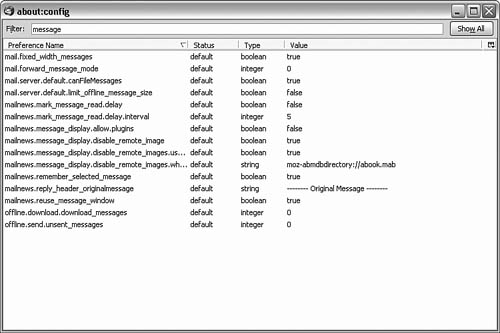
Figure 13.7. The filter in the about:config extension lets me see only those preferences that meet my search filter.
To add a new preference, right-click anywhere in the about:config preferences list and select New, (type) from the pop-up menu. You can also copy a preference’s name or value to the Clipboard, modify the preference, and optionally reset it if the preference is not the default value.
Three configuration files are designed to be modifiable by the user. None of these files are present by default, so you must create them:
user.js—. This is the first file you can create, and it’s the file that’s used to hold preferences that will be merged into theprefs.jsfile by Thunderbird. If the preference already exists inprefs.js, it is updated with the value fromuser.js. After they have been merged intoprefs.js,user.jsserves no purpose until it’s modified again. If you deleteuser.js, the changes that were last loaded from it remain inprefs.jsunless specifically removed (with eitherabout:config, or by editing).userChrome.css—. The way that Thunderbird looks to the user can be customized in this file. It’s similar to a theme, although not nearly as powerful, and you can change fonts, colors, and various other attributes for Thunderbird.userContent.css—. This file controls the way content looks in Thunderbird.
Manually changing configuration files can be done with a compatible plain-text editor. Rather than attempting to modify prefs.js, it is better to enter your changes in user.js.
Creating and modifying userChrome.css and userContent.css, at least initially, can be tedious. After you learn the ins and outs of Cascading Style Sheets, things get easier (refer to Chapter 6, “Power Firefox Tricks and Techniques”).
Here are a few ideas from the experts:
Thunderbird uses themes to customize its user interface. You can download themes from the Internet and write your own themes.
There is limited support for customizing the Thunderbird toolbars. Without using extensions, only a small set of predefined buttons can be added to the toolbar. Extensions can add more buttons to the group you can select from.
As with any program, it is important to back up Thunderbird’s profile. The profile contains the configuration for the user and that user’s email. Lose the profile and you also lose your email.
Extensions create new functionality in Thunderbird. They are easy to install, and you can write your own extensions.
By using the
about:configextension, many of Thunderbird’s preferences can be altered to suit your needs. The extension frees you from the problems of trying to manually editprefs.jsanduser.js.
